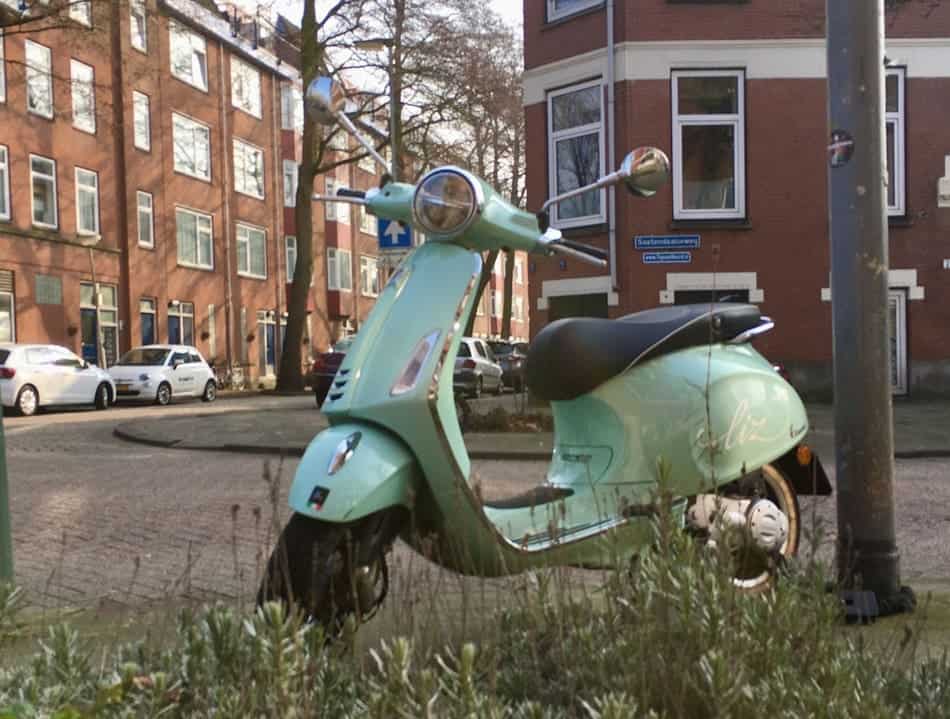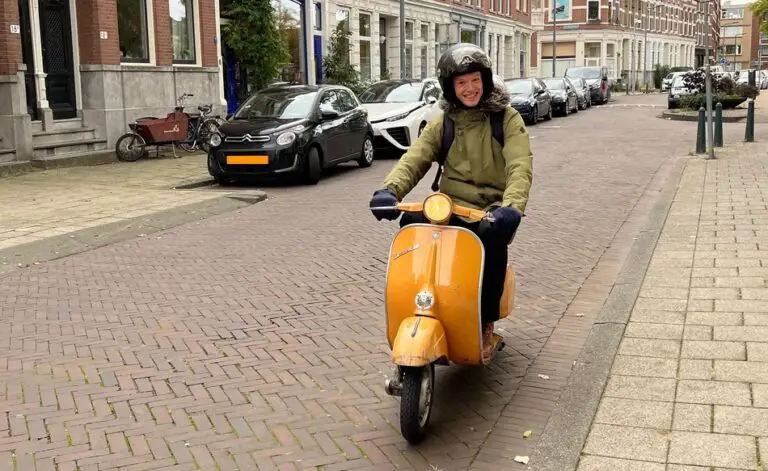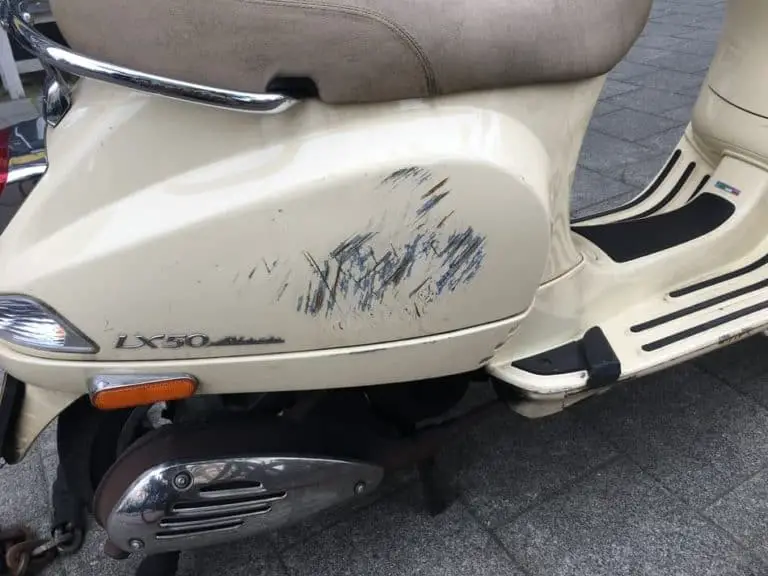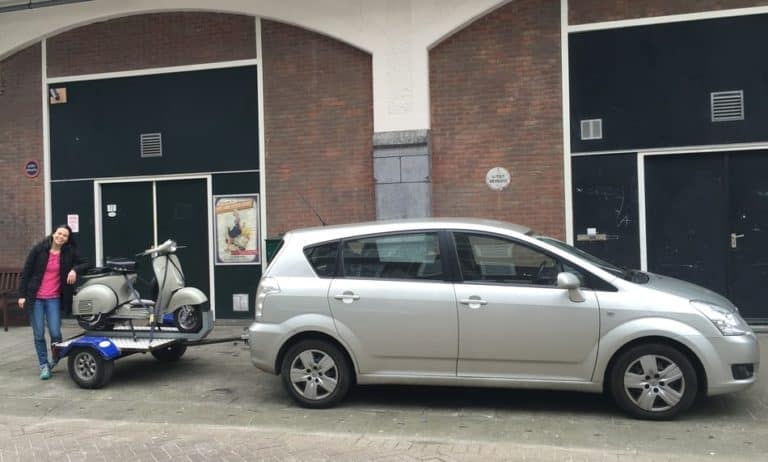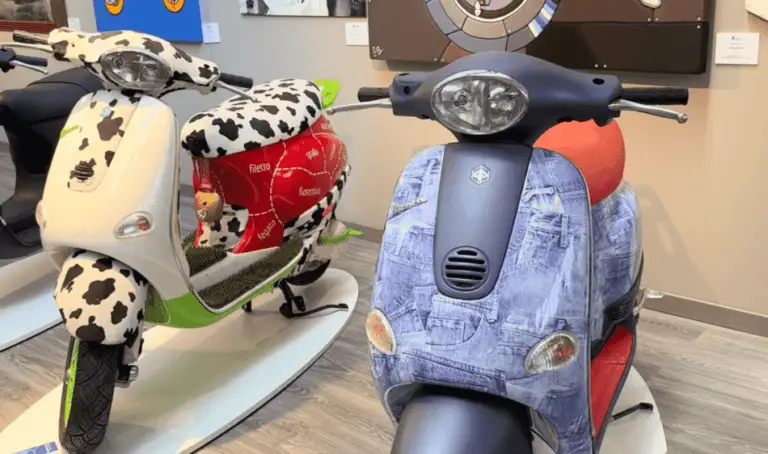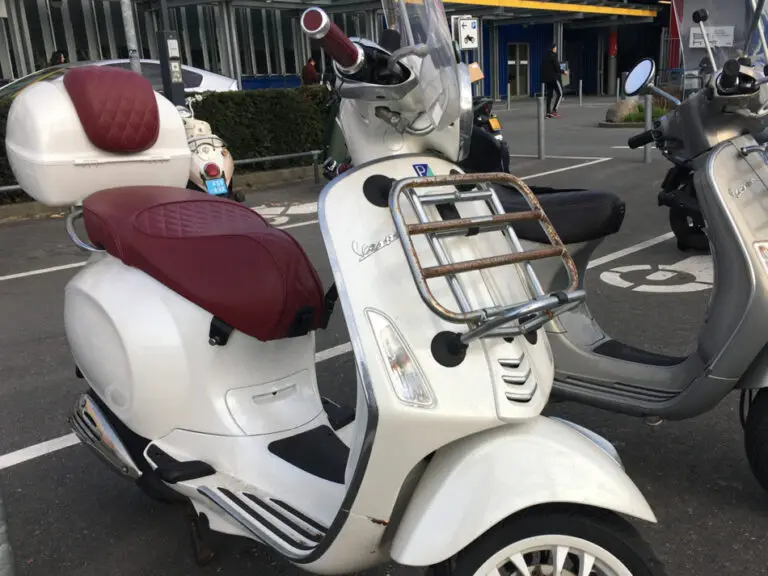How To Park A Vespa Properly? 6 tips to safely park your scooter
One of the advantages of owning a Vespa is that it is easier to find a parking space than a car.
However, parking a Vespa isn’t always as straightforward as it may seem. Sometimes finding a nice parking space isn’t enough to safely leave your Vespa behind. Before you know it you are fined because you parked your Vespa incorrectly. Or even worse your Vespa will be lying on its side because of heavy winds and you have to deal with a serious dent or other damages.
To make sure you did everything you could to avoid any trouble or damage to your Vespa we have listed 6 things you can consider to properly park your Vespa.
1. Park the Vespa on its center stand
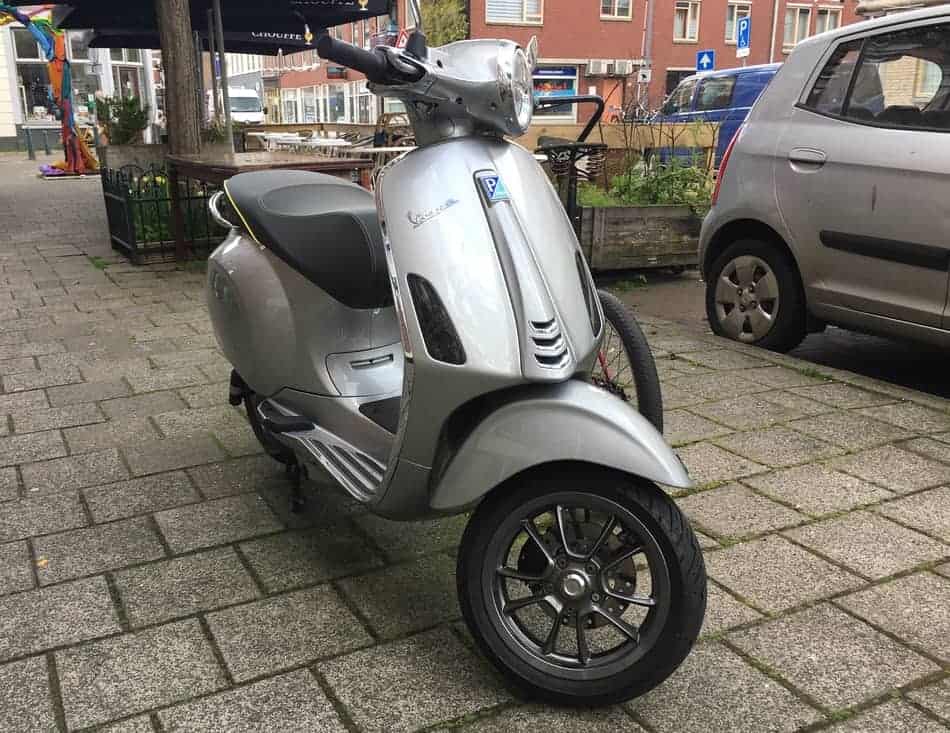
Whether we are talking about a Primavera, Sprint, or a large frame GTS model, a Vespa is heavy. Unlike other scooter brands, a Vespa is made from steel.
Your first thought might be that it is way too difficult to put a heavy vehicle like a Vespa on its center stand (also known as a kickstand). But like many things in life, it is not about strength. If you know how to do it you don’t need to use a lot of force.
It might be tempting to replace or use a side stand to park your Vespa instead of the center stand. But don’t use a side stand for a Vespa at all costs. The Vespa will easily tip over if the surface isn’t even enough. You will regret it terribly when you find your Vespa on its side.
Always use the center stand (kickstand) to park your Vespa.
While a side stand is easy to handle for anyone, a center stand is just as easy and more stable. You just have to know the easy trick to get the Vespa on the center stand.
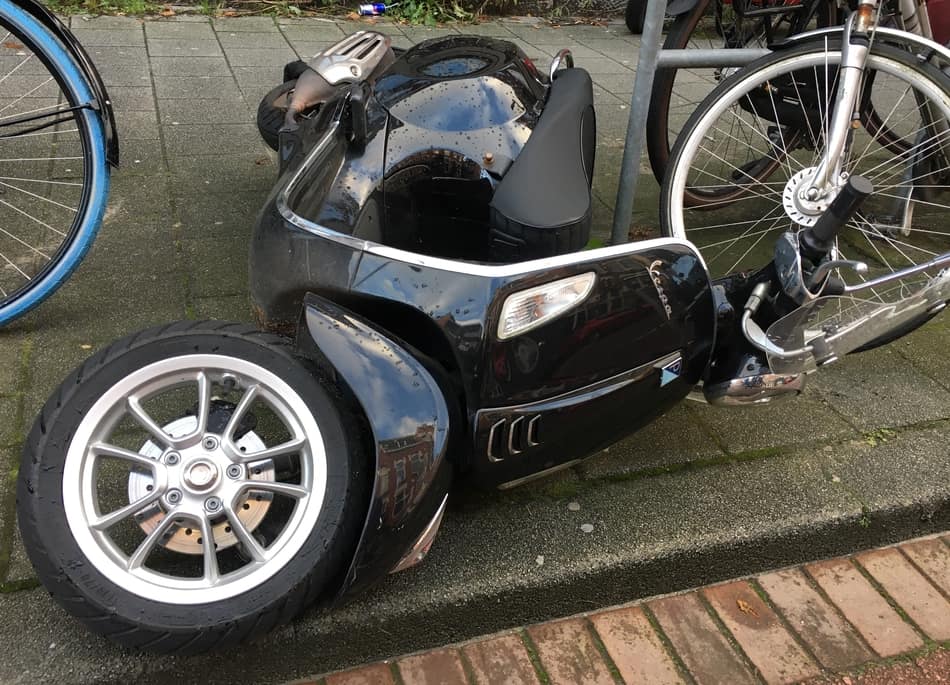
So how to park your Vespa on the center stand? These are the 7 easy steps:
- First, don’t place both hands on the handlebar to pull the Vespa backward onto the center stand. This can only work if you are tall and very strong. And since a Vespa is made for everybody, there is an easier way.
- Stand on the left side of the Vespa. This is where the lever for the center stand is located.
- Keep your left hand on the left handlebar and your right hand on the chrome bar located just next to your seat.
- Twist your body half a turn. You will now be facing the back of the Vespa.
- Place your right foot on the center stand lever.
- Push the lever down while stabilizing the Vespa with your right and left hand. You don’t need to use any muscles in your arms to do this. You are only stabilizing the scooter with your upper body while pushing the lever down with your leg.
- Use your weight, and push it back, downwards. The Vespa will easily fall on its center stand, light as a feather. You will get the hang of it once you do it a couple of times.
Use the same positions of the hands when you are pushing the Vespa in reverse. It is easier to maneuver this way, especially in tight parking spaces.
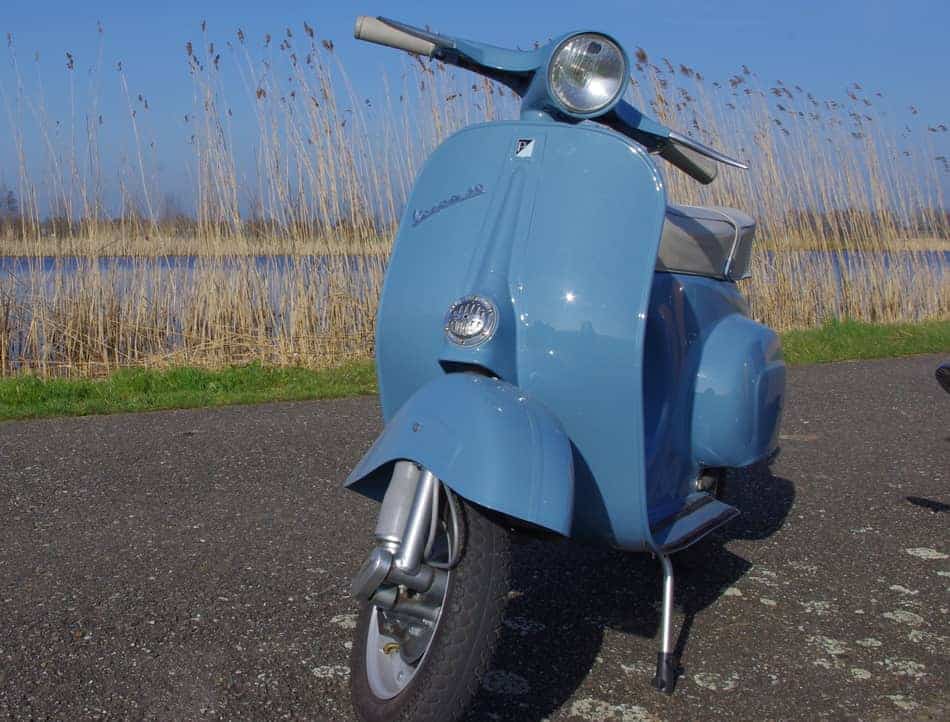
You can’t use the 7 steps mentioned earlier for a classic Vespa. It is just too low plus it doesn’t have a center stand where you can place your foot on. In the case of placing a classic Vespa on the center stand you DO need to pull the handle with both hands. It can be heavy and you have to be careful not to lose balance. Before you know it your precious Vespa will be lying on its side.
To avoid a classic Vespa from tipping over when placing it on the center stand, try to apply the following things :
- Hold the handlebar with both hands
- Pull the handlebar towards you and at the same time push the center stand down with your foot
- To be on the safe side, lean the Vespa just slightly towards you. If you do lose balance, at least you can catch it easier if it falls towards you.
- Once the center stand is almost touching the ground, place your foot firmly on the ground to block the center stand from being pushed backward instead of down.
- The steering wheel will go up making it easier to place it on the center stand since the back will be going downwards.
Getting the Vespa off the stand
You can get the modern and classic Vespa off the center stand by holding both handlebars and placing the feet on both sides of the Vespa. Don’t take a seat yet. Instead, push the Vespa forward. The Vespa will easily fall off the center stand. You can then take a seat immediately and start the engine.
Make sure that you unlock the steering lock first before pushing the Vespa from the stand. I’ve seen this go wrong many times. If the handle bar is locked then it will be facing left. So if you would push it from the stand while it is still on the steering lock, chances are you will loose balance and the Vespa can fall on you.
2. Avoid parking on the sidewalk
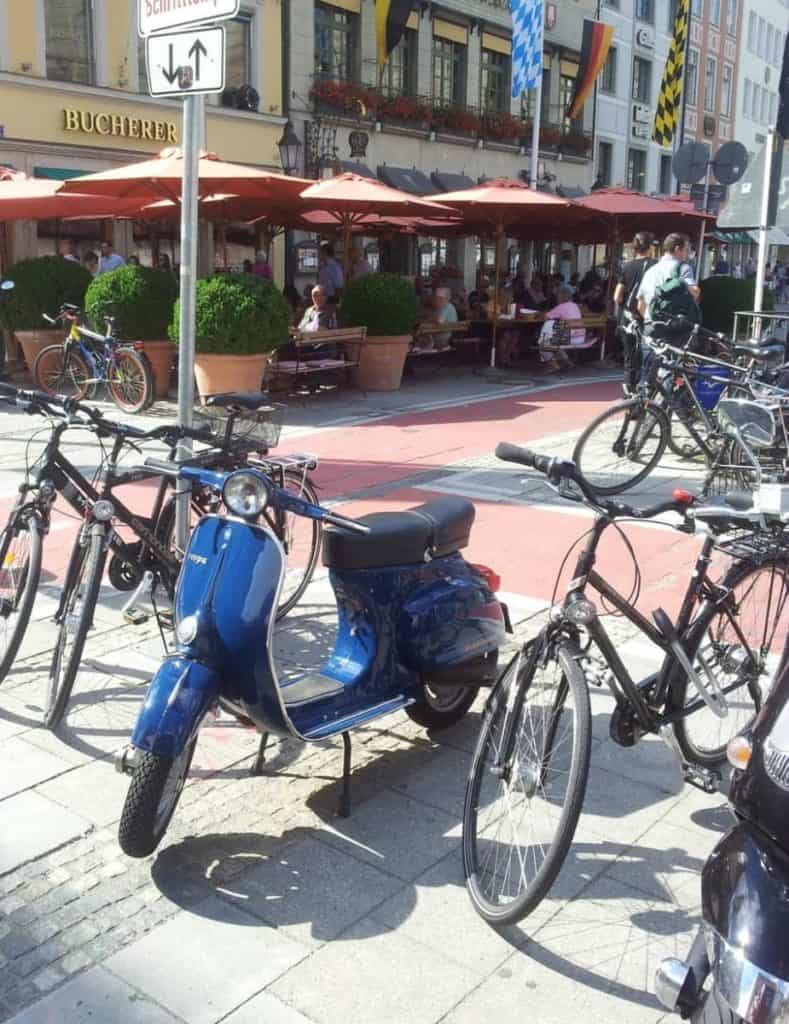
Before you even want to shut down the engine and lock your Vespa, you need to know if you are even allowed to park there. Often scooters are not seen as motorcycles and therefore it is tolerated if it isn’t parked in a designated parking spot. Nevertheless, you should be aware that as a Vespa driver you need to abide by the same rules as any other motor vehicle, this includes parking.
The laws on parking a motorcycle, moped, and scooter not only differ per country but also per state in the USA. So you can imagine you can go wrong pretty easily.
In most cases, you are not allowed to park a Vespa on the sidewalk. Even though it is illegal, you will probably still see Vespas parked on the sidewalk. It is convenient and it doesn’t really seem to bother anybody. In some cities, it is tolerated, even the big ones such as New York, San Fransico, Amsterdam and Paris. You just need to make sure you park politely and almost invisibly.
Here are a couple of tips on parking a Vespa on the sidewalk even if it isn’t officially allowed:
- First of all, make sure there is no sign where it states that it is prohibited to park.
- Double-check if there is no designated parking area for bikes. For instance, many parking garages or retail parking have special areas for scooters to park.
- Make sure you are not parked right in front of a shop, as the pavement might be privately owned.
- The pedestrians, medical vehicles, and those loading and unloading must have full access to the sidewalk.
- Make sure fire hydrants are fully accessible
- Park near something big, such as a tree, advertisement billboard, street light, or between objects such as a tree and a pole.
- Never remove your license plate to avoid getting a fine. The law enforcement officer is more than happy to impound your Vespa without a second thought.
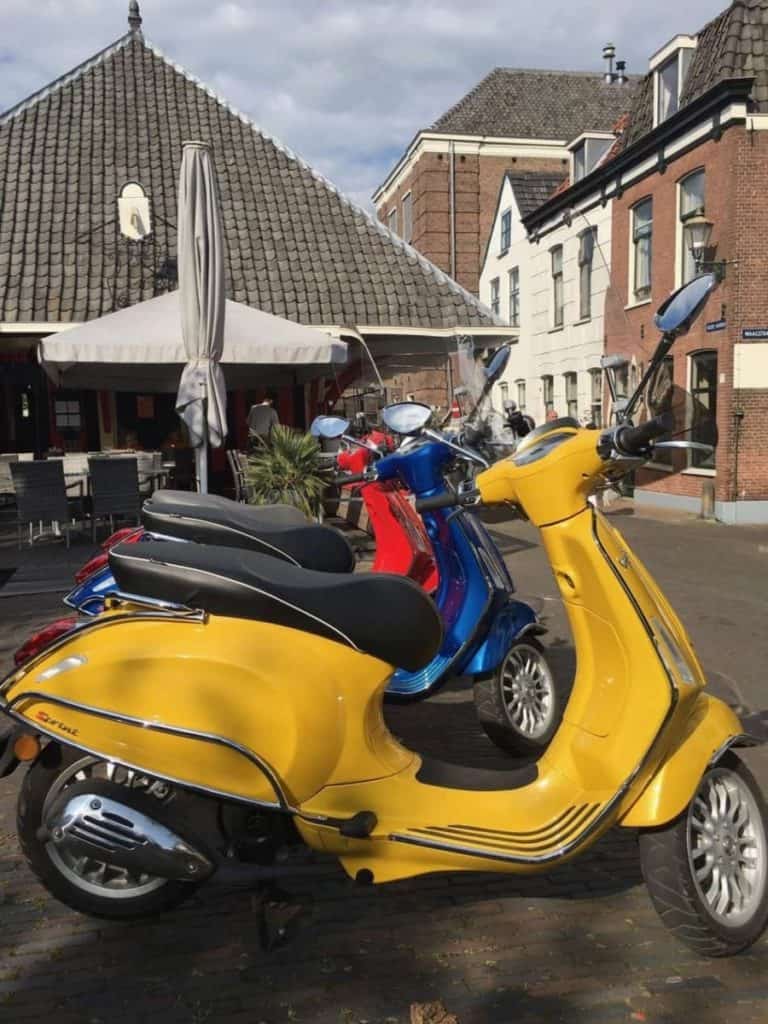
That said, check specifically the local parking laws for the area. Some cities, such as Philadelphia have a daily parking rate of USD5 for motorcyclists. In this case, you must park your Vespa in a parking spot. You will not get away with parking on the sidewalk here or in any other city that has the same parking rules.
Besides specific laws on where to park, some cities also have laws on how you should park a scooter or motorcycle on the street. In many cases, if you want to park your Vespa on the side of a street you have to park it perpendicular/90-degrees angle to the curb. Your wheel must touch the curb once you are parked.
It is common to park on the side of the street but to prevent damage avoid parking behind or in front of a car. Just a little push of a car and your Vespa will fall over. Large cars such as SUVs and pick-up trucks will not always be able to see a Vespa when going into reverse.
3. The front wheel should touch the line of the parking spot
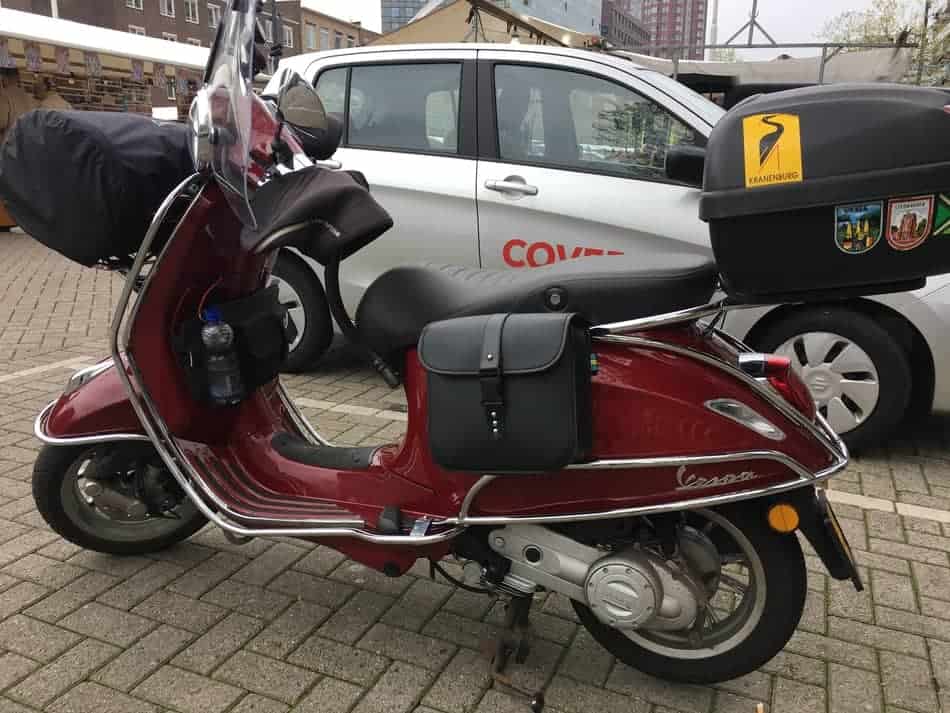
A parking area is a good and safe place to park your Vespa, if you do it properly. While it might be a bit strange to use the whole lot for just your Vespa alone, you are allowed to do so. However other drivers would appreciate it if you leave some space for another motorcycle or Vespa to park there too.
So to make sure that you park your Vespa safely in a parking spot while using the right parking etiquette you can follow the next steps:
- Once you find a spot, stop in front of the parking space and switch off the engine. It is best to back into a parking space than to drive straight in. However, it is more difficult to back up from a parking space as space is more limited.
- If your feet easily touch the ground then you can stay seated on your Vespa and back in while using the mirrors. To make sure you don’t bump into a parked car it is best to step off your Vespa. Stand on the left side of the Vespa while holding your left hand on the handlebar and the right on the seat bar, located on the back. Then face backward and push the Vespa with your legs to the desired parking spot. Use your left hand to guide it properly and your right hand to stabilize it.
- Then park your Vespa as far forward as possible, with your tire touching the line of the parking spot. It is important your tire is visible to cars passing by and searching for a spot. If your Vespa is parked too far back a car will easily drive in and bump into your Vespa. Parking to the far front also prevents you from getting blocked by other motorcycles who want to share the parking space with you.
- Park to the far left or the far right of the parking space. Generally speaking, four motorcycles can use a parking space. Leave enough room in the middle of the parking space so that those who want to park in the back can easily pass the two parked bikes in the front.
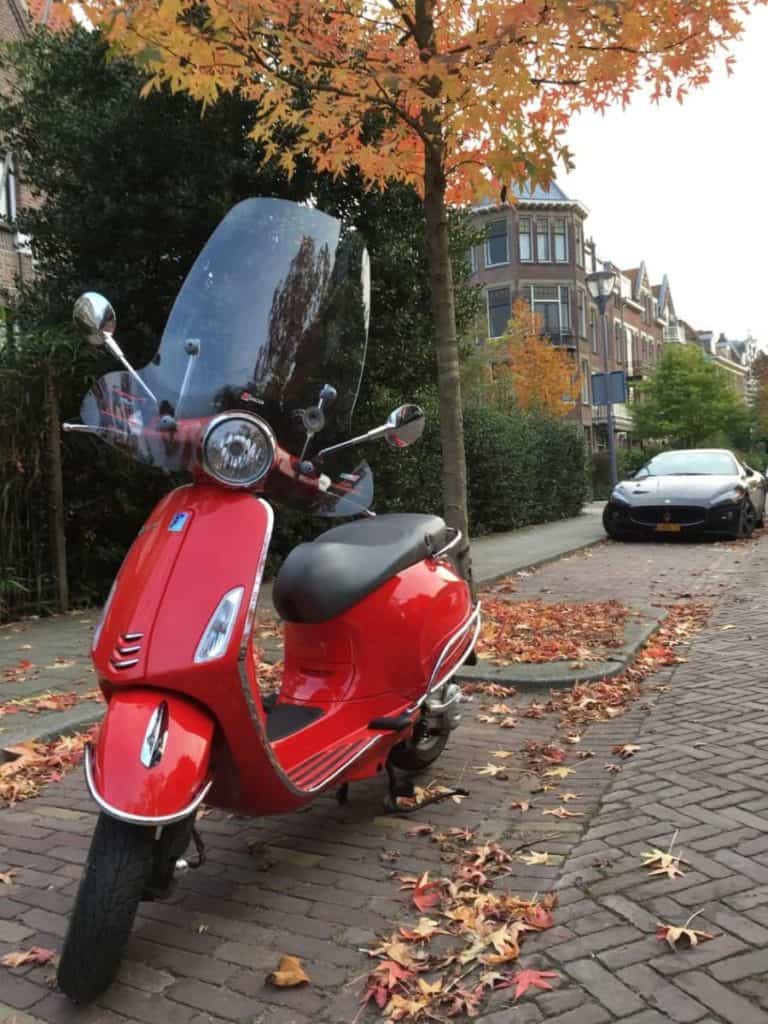
If it is a parallel parking area then it is best to park your Vespa with its rear-wheel against the curb. Make sure you park it at such an angle that the front wheel is still within the parking space. Parallel parking areas however aren’t really a safe place to park a Vespa. If there is some space left some car drivers will try to park right next to your Vespa. As you can imagine, little accidents can happen and your Vespa is the one that will fall over and have the most damage.
Don’t be tempted to park your Vespa between two cars that are neatly parked parallel within two parking spaces. Not only is this illegal especially if it is a paid parking spot, but your Vespa can also get damaged by a car trying to leave or park in one of the parking spaces.
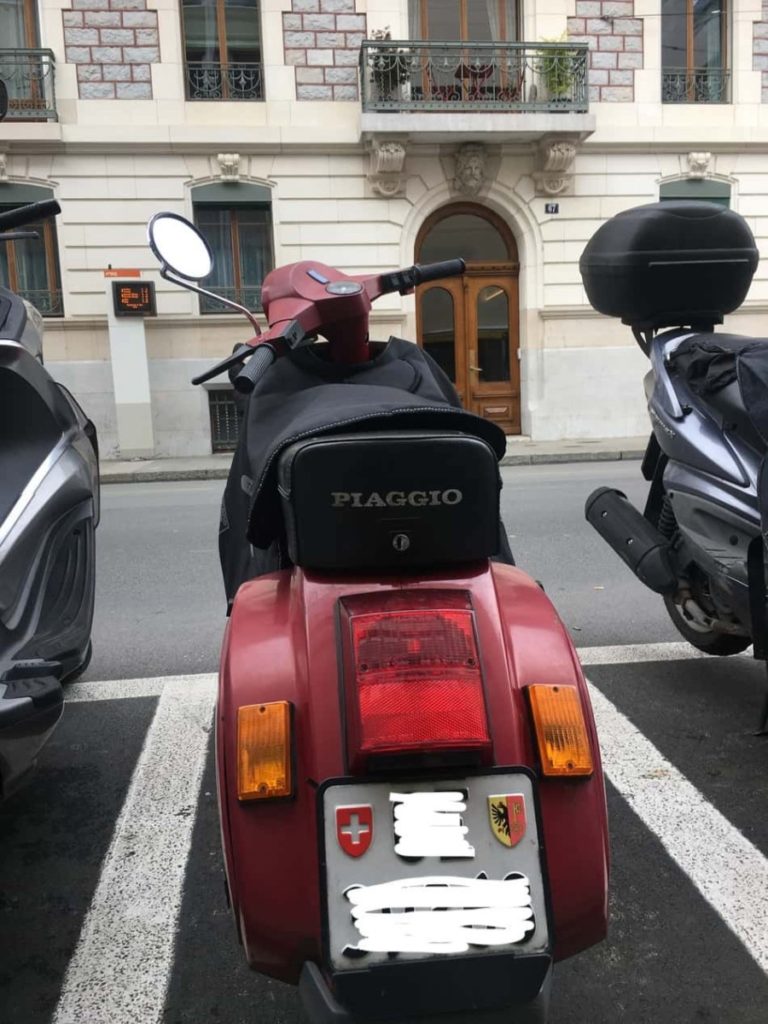
4. Park your Vespa with the front wheel facing uphill
Unlike a motorcycle, a Vespa has a center stand which makes it more difficult to fall over. The center stand is pretty crucial when parking on a hill as it is equipped with a small lever on the side. You can place your foot on the lever when pushing the Vespa on its center stand. However, the lever also creates more stability once on the ground and it ensures that the Vespa doesn’t tip over.
The first thing to remember when parking a Vespa on a hill is that the front wheel should always be facing uphill. On less extreme steep hills you can also park it at a 45-degree angle with the rear wheel touching the curb for extra stability. Also, make sure that the tiny lever on the center stand is pointing down the hill. It will carry the weight of the Vespa ensuring more stability.
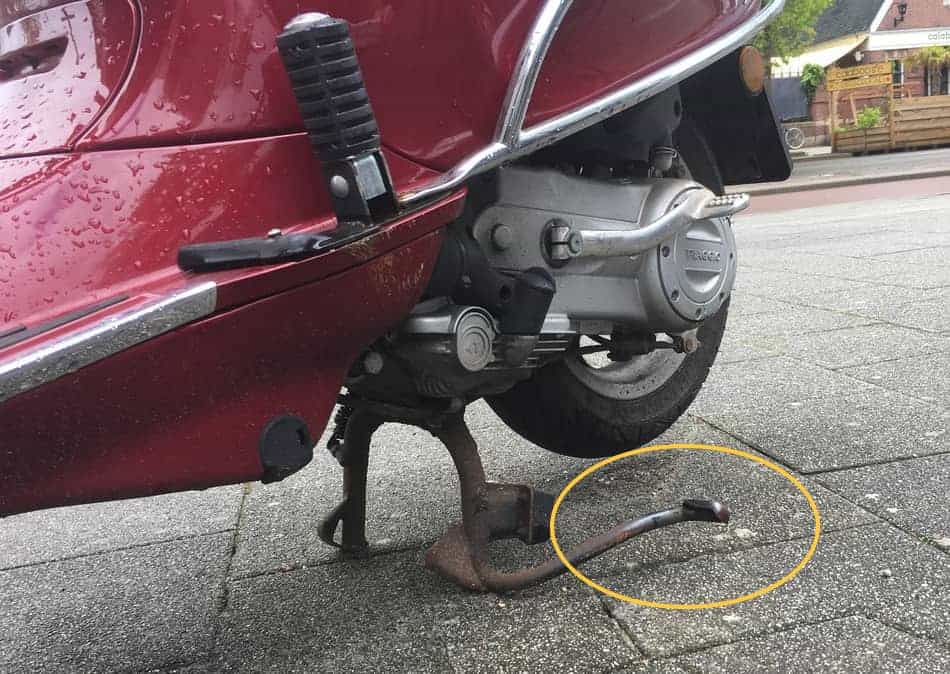
Motorcycles usually need to leave their bike in first gear when parked on a hill to prevent them from rolling backward. This is not relevant for the modern automatic Vespa. As for the classic Vespa, it is an option to park it in first gear. However, if you place it on the center stand then you should be ok.
Once you have parked your Vespa on the hill, give it a nudge to check if it is parked stable enough. Maybe you need to turn the front slightly more uphill.
5. Park your Vespa facing forward into the wind
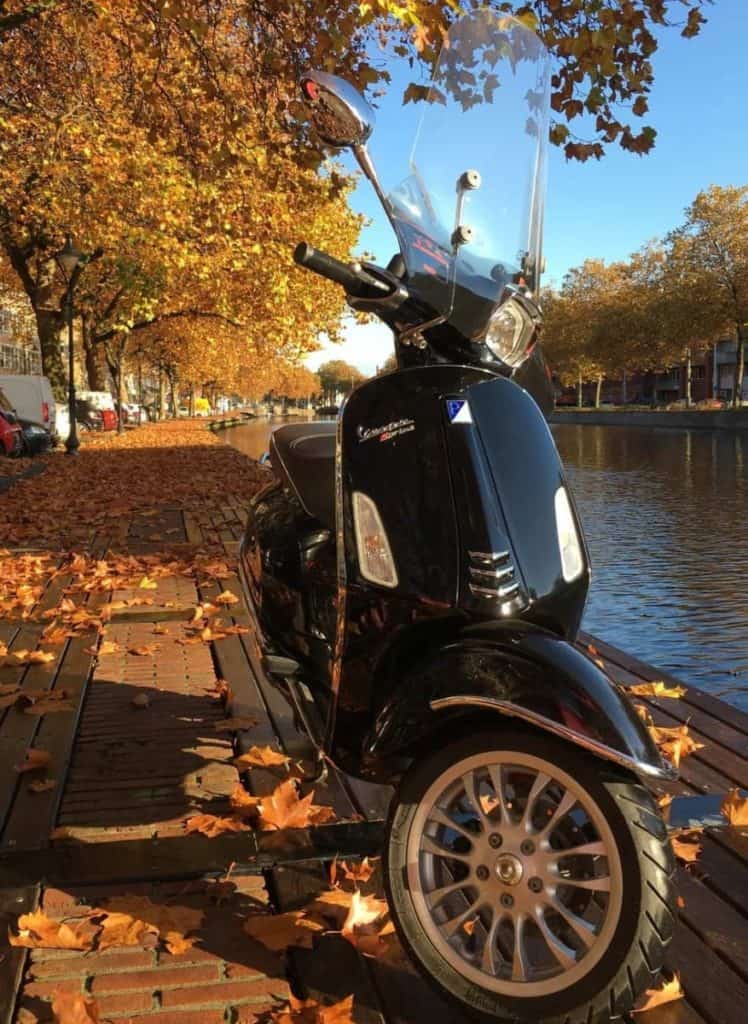
Unfortunately, the wind is one of the biggest causes of damage to a Vespa. A gush of wind can easily tip your Vespa over leaving it lying on the ground. Always a painful sight to see, even if it isn’t yours.
Vespas with a windshield are more likely to fall, so more caution is needed when parking in windy conditions. Also, the modern Vespa Primavera and Vespa Sprint are known to have a narrow center stand, making them more prone to tip over due to heavy winds.
So what is the best way to park your Vespa on a windy day?
Let’s start with the obvious. Find a place where your Vespa is secluded from the wind, for instance behind a wall or in a parking area. But since this is not always an option, you should consider these things that will help to avoid the wind pushing your Vespa on its side:
- Check the direction of the wind and find a level surface to put the Vespa properly on the center stand.
- Place the front of the Vespa facing forward into the wind. This is crucial if you have a windshield. If you don’t have a windshield then it is ok to place the rear of the bike facing the wind as well. But no matter what, never park the Vespa with the wind coming from the side.
- Don’t use a scooter cover with strong winds. The cover will be like a huge sail and will bring the scooter down.
- For extra stabilization from the wind, you can lock your Vespa to a fence or a pole while also applying the previous points mentioned. Try to wrap the chain tightly around the Vespa and object leaving less space for the wind to push the scooter.
6. Lock your Vespa with a quality chain lock
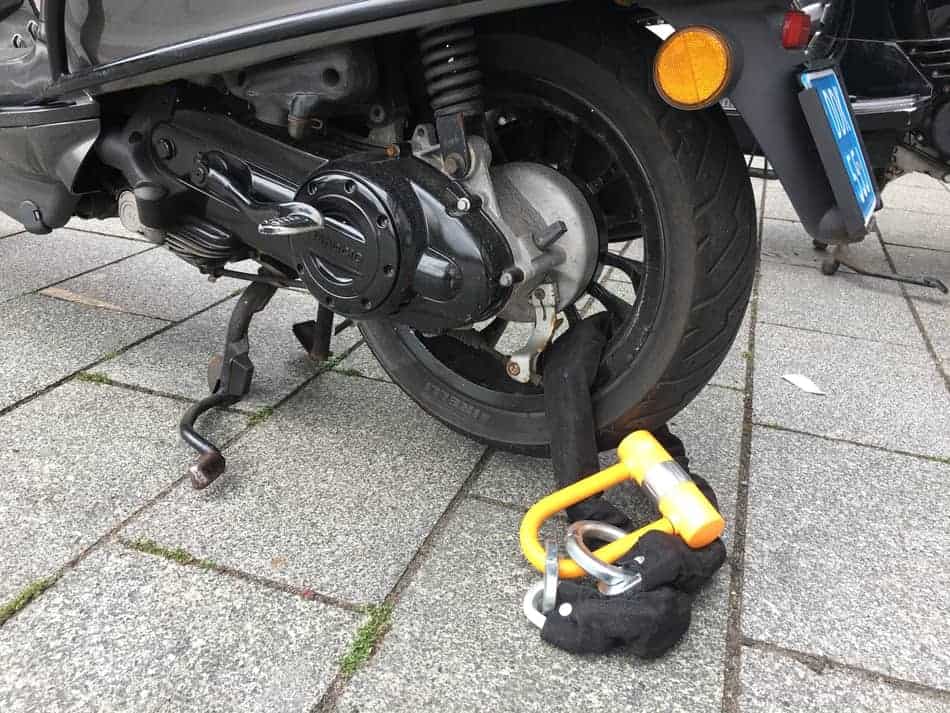
A Vespa is susceptible to theft so it is important to lock it properly once parked. The Vespa steering lock isn’t enough. You will need a good chain lock as well. In Europe, the best locks are those with an ART4 certification. ART is an organization that focuses on theft prevention. So if you buy an ART4 certified chain lock then you are sure you have the best you can get.
In other continents, you need to do a bit more research as the ART4 certification isn’t applied. However, these brands make quality and extremely good chain locks:
- Abus
- Kryptonite
- Pro-Tect
- Vector-Pro
- OnGuard
The most convenient is the chain locks that are 1,5m long so you can easily attach your Vespa to an object. Use a lock to secure the Vespa to something heavy such as a streetlight, small tree, or fence. There are cities that have bike racks. In some places, you are allowed to attach your Vespa to it, but in other cities such as Chicago, this is not tolerated.
Always place the chain through the rear wheel as this is takes the longest to remove. This is also the way to lock the Vespa if you can not attach the lock to something.
To avoid your Vespa being stolen try to park it at busy places where the crowd can alert the police if they notice something.

